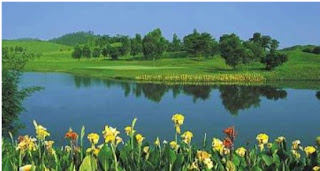Golf Courses in Asia Have Mostly Been Carved Out of
Padi Pields or Virgin Rainforests.
THERE is a long-standing relationship between golf and nature. Golf courses are integrated with their surrounding landscapes, the vegetation that flourishes in the area and the wildlife that they support, albeit not entirely.
The greenery of golf courses, often lush, is meant to enhance the natural environment and not cause harm. Inadvertently, though, the balance of nature is disturbed with the intrusion of people. However, if properly sited, designed, constructed and managed with a consciousness of caring for nature, golf courses can actually turn out to be environmental assets. They can help protect the biodiversity of the surroundings.
Having said that, a lot of real estate developers, and indeed most golfers, do not realise that random construction of courses – without due environmental awareness – can damage the very nature that players seek to enjoy. So, developers who build golfing havens but are insensitive to the consequences of indiscriminate construction are in reality simply creating nightmares for the environment and its guardians.
According to data from the International Association of Golf Tour Operators (IAGTO), there are some 34,000 golf courses in the world today and about 50 million golfers. And the business of building golf courses is among the fastest-growing type of land development.
On top of that, golf tourism is rapidly gaining momentum with estimates that the global industry is worth US$30bil a year. The game seems poised to continue its expansion across the globe, especially in Asia where the development of golf courses is escalating. The golf craze has also spread to the emerging economies of Vietnam, Laos, and Myanmar. Other markets that are attracting golf developers in droves are India and China (which boasts one of the world’s largest golf resorts, the Mission Hills Golf Club & Resort).
Many of the golf courses in Asia have been carved out of padi fields or virgin rainforests. Vegetation is cleared, trees are cut down, artificial landscapes are created and golf developers promise breathtaking views of the sea or mountains. These are then touted as golfers’ paradise, but the concern is the high price that nature has to pay.
It is said that golf development is becoming one of the most unsustainable and damaging activities to people and the environment. In some Asian countries, conflict has broken out between farmers and the golf industry with the former being forced to sell their land to golf course investors.
Fertile farming land becomes obsolete with the development of golf courses. It is worse in the highland areas where the ecosystem is fragile. Then there is the indiscriminate use of improper chemicals. Golf courses need large quantities of pesticides, fertilisers and herbicides that cause health problems among golfers, workers and residents living nearby.
Unfortunately, these issues are overlooked by irresponsible individuals in the industry who are only interested in cashing in on the booming golf trade. During the intense golf boom of the 90s, many golf courses mushroomed in Malaysia. In some environmentally sensitive areas, prime tourist attractions were affected as a result of poor planning of golf courses. Developers were either oblivious or not concerned with the damage that was being done to the environment then.
Today, environmentalists are ensuring that the public is being informed about the effects of golf course construction and some of the social ramifications that are linked with golf courses – about the chemicals used and the health risks they pose to humans and wildlife.
There are also concerns about the large amounts of water needed to upkeep the greens and fairways.
Realising the importance of protecting the environment, the Environmental Quality Act 1987 was gazetted and enforced on April 1, 1988. It required Environmental Impact Assessments (EIA) for certain activities, including the development and construction of golf courses.
The Department of Environment (DOE) is largely responsible for ensuring that the EIA requirements are adhered to. The sudden boom of golf courses worldwide brought about the formation of the Global Anti-Golf Movement. Formed in the 1990s, the movement is calling for a freeze on all golf course development and an open audit and environmental review of existing golf courses. The grouping also wants golf courses to be converted into parks and investigations into illegal occupation of public land, encroachment into protected forests, diversion of water, and violation of corporate regulations.
Fourteen years ago, the movement launched a World No-Golf Day on April 29. In the same year, a three-day conference on Golf Course and Resort Development in the Asia-Pacific Region was held in Malaysia. It was sponsored by Japan-based Global Network for Anti-Golf Course Action, the Thailand-based Asian Tourism Network and the Malaysian-based Asian-Pacific People and Environmental Network.
In places like the United States, United Kingdom and Australia, golf course developers have to adhere to strict guidelines. Not a single tree can be chopped down without a valid reason. In Asia, it is still not so. It’s not the golf courses per se that are the problem; the main culprits are the irresponsible golf course developers.
There are ways golf courses can help protect the environment.
Proper golf course management is the answer. Golf course management is not just about a club boasting a well-maintained and challenging course; it is about the overall management of the golf course including the clubhouse, the maintenance, the pro-shop and other elements in the area. It is about understanding the wide range of habitats beyond the fairways and greens. Colin Montgomerie, one of Europe’s top players, once said: “A golf course which has been sensitively designed and managed in a way that works with nature rather than against it, is normally more interesting and challenging.”
For him and for many other professional golfers, a natural course is an opportunity to get back to the roots of the game. It is, in the golfer’s words, “a test against the hazards that nature provided”. Interestingly, in Scotland where there are over 600 golf courses, strong measures are taken to ensure that the courses are environmentally friendly. Today, golf courses must address environmental issues like water quality and usage, habitat and biodiversity loss, chemical use, waste, energy use, among others.
In the United States, through the Audubon International’s environmental education programmes, golf course owners, managers, and superintendents are helping to protect and sustain the environment in their communities. Audubon International is an organisation that works with golf courses to help them provide habitat for a variety of wildlife species and preserve the rich natural heritage by protecting native plants.
In Asia, golf courses registered with Audubon International include Kau Sai Chau Golf Club in Hong Kong, Lake Mclaren Golf Club in Shanghai, Forest Hills Golf & Country Club, Manila Southwoods Golf & Country Club and Santa Elena Golf Club in The Philippines and National Service Resort & Country Club in Singapore.
Clearwater Sanctuary Golf Resort in Batu Gajah, Perak, and Kota Permai Golf & Country Club in Selangor are Malaysian clubs registered under the Audubon Cooperative Sanctuary Programme. According to Normas Yakin, Kota Permai club manager and vice-president of the Golf Course Superintendents Association of Malaysia, golf clubs have to adhere to stringent requirements if they want to be registered under Audubon International.
Are golf courses in Malaysia environmentally friendly? Most of the golf courses, said Normas, are striving to be environment-friendly. “Most course superintendents work outside in the environment and they would like the environment to be good. But sometimes their hands are tied because of financial constraints,” he said.
He revealed that in a bid to cut costs, some golf courses used chemicals meant for plantations.
One of the ways golf clubs can help conserve the environment is to ensure careful use of fertilisers and pesticides. Using a lot of chemicals does not automatically result in good turf and chemical dependence is definitely not good for the golf course and the environment.
“Previously, chemicals were used as a preventive exercise. This is not good because the pests become immune to the chemicals and then a stronger chemical is needed to kill them,” said Normas, who is also a member of the Golf Course Superintendents Association of America. “Today, we are taught to use chemicals as a curative exercise, that is spraying only the affected area. Indiscriminate spraying as a preventive measure is not advisable.” Also, he adds, slow-releasing fertilisers should be used because they remain in the ground and do not leach out.
Normas reckons that environmentalists can help by pushing for legislation on guidelines and standards that golf courses must adhere to. Indeed, nature will be protected if golf courses are designed, constructed and managed responsibly. After all, golf courses by their very nature are significantly intertwined with the environment.
Feature: By Malkeek Kaur
Thanks To Dr. Nor Malina Malek




No comments:
Post a Comment